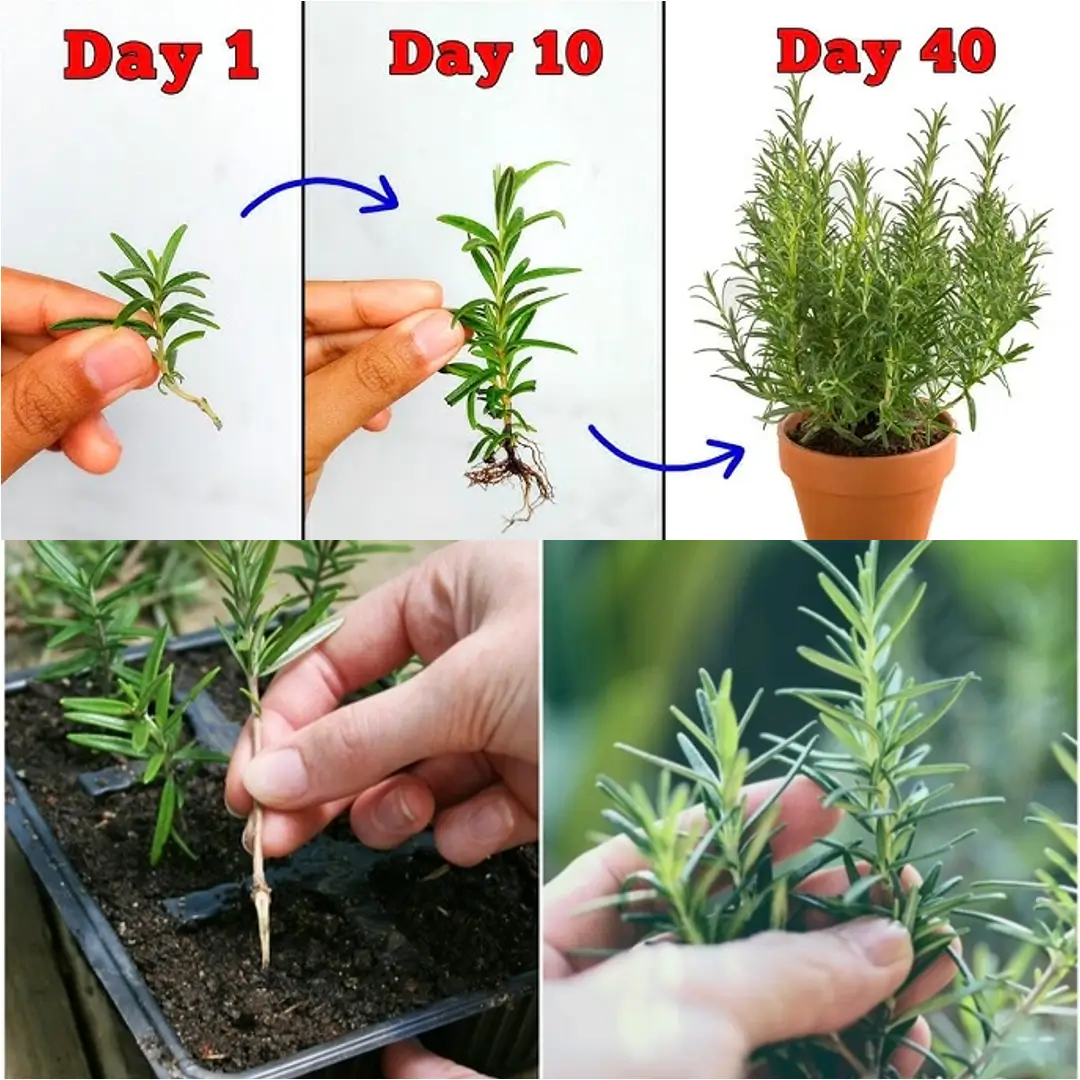Grow rosemary is not just a gardening endeavor; it’s an aromatic journey that can enhance your culinary experiences, beautify your garden, and even benefit local wildlife. This hardy herb, native to the Mediterranean, is beloved for its fragrant leaves and stunning flowers. In this extensive guide, we’ll dive deep into everything you need to know about how to grow rosemary successfully, ensuring that you can enjoy this delightful herb all year round.
Ideal Conditions to Grow Rosemary
Before we get our hands dirty, let’s talk about the ideal conditions for growing rosemary. The right environment is crucial for ensuring robust growth and healthy plants. Here’s what you need to know:
1. Sunlight Requirements
Rosemary thrives in a sunny environment—a minimum of six to eight hours of direct sunlight daily is ideal. Think of it like this: just as we feel energized by the sun, rosemary plants absorb sunlight to fuel their growth. Choose a location in your garden that is sheltered from harsh winds and receives plenty of light. The warmth of the sun encourages not only growth but also the development of those flavorful, aromatic leaves.
2. Soil Type
When it comes to soil, well-drained is the name of the game. Rosemary doesn’t like sitting in water, particularly during those soggy winter months. If you’ve got heavy clay soil, you might find that your rosemary struggles to survive. To combat this, you can amend your soil by mixing in bark, grit, or leaf mould to enhance drainage. Picture it as giving your rosemary a cozy bed to thrive in!
3. Container Gardening
If you’re short on garden space or living in a colder climate, don’t fret! Rosemary can be grown in pots, making it versatile for various situations. Just keep in mind that rosemary can grow quite large, so choose a container that allows for growth. Ensure it has drainage holes to prevent water from pooling at the bottom, and remember to repot every couple of years in fresh compost. This refresh keeps your rosemary happy and healthy!
Planting Rosemary
So, you’re ready to grow rosemary! Let’s cover the essentials for getting those little plants into the ground.
1. When to Plant
The best time to plant rosemary is during spring or autumn. These seasons provide the ideal conditions for establishing healthy roots before the extremes of summer heat or winter cold set in. Consider this: planting at the right time is like laying a solid foundation for a house. It sets the stage for everything that follows!
2. How to Plant
- Prepare the Soil: Start by loosening the soil to a depth of about 12 inches. Mix in some organic matter like compost to boost nutrients.
- Dig a Hole: Make a hole that’s slightly larger than the root ball of your rosemary plant. You want it snug but not cramped—think of it as giving your rosemary a comfortable space to spread its roots.
- Place the Plant: Position the rosemary in the hole, ensuring that the top of the root ball is level with the soil surface. This will help the plant absorb moisture more efficiently.
- Backfill and Water: Fill the hole with soil, gently pressing down to eliminate air pockets. Finally, give it a good drink of water to help the plant settle in.
By following these simple steps, you’re well on your way to growing a thriving rosemary plant!
Care and Maintenance
Now that your rosemary is planted, let’s talk about how to keep it thriving. Caring for rosemary doesn’t have to be complicated; with a few simple practices, you can ensure your plants flourish.
1. Pruning
Pruning is essential for keeping rosemary plants healthy and productive. Aim to prune annually, preferably after flowering. This not only prevents the plant from becoming woody and straggly, but it also encourages new, bushy growth. Think of it as giving your rosemary a stylish haircut—fresh and revitalized!
2. Mulching
In the autumn, it’s wise to apply a layer of mulch around the base of your rosemary plant. Materials like leaf mould, well-rotted compost, or manure will protect the roots and provide extra nutrients. Mulching is like wrapping your plant in a cozy blanket during the colder months, keeping it warm and snug.
3. Watering
Keeping your rosemary well-watered is crucial, especially during those dry spells. However, remember that if you want to grow rosemary, it prefers to be slightly dry between waterings—overwatering can lead to root rot. A good rule of thumb is to water deeply but infrequently, allowing the soil to dry out between sessions. It’s a delicate dance, but once you find that rhythm, your rosemary will thank you!
4. Feeding
During the growing season, consider feeding your rosemary with a general fertilizer. A balanced mix will promote healthy growth without overwhelming the plant. Just like we need a balanced diet, rosemary thrives when it receives the right nutrients!
5. Winter Protection
If you live in a colder climate, don’t forget about winter protection! Bring container-grown rosemary indoors to shield it from frost, and consider covering plants in the ground with a frost cloth or extra mulch for insulation. It’s like giving your rosemary a warm winter coat!
Harvesting and Storing Rosemary
Once you successfully grow rosemary and it is established and thriving, you’ll want to enjoy its flavorful leaves in your cooking. Let’s explore how to harvest and store this fantastic herb.
1. Harvesting
Harvesting rosemary is a simple and rewarding process. You can pick sprigs throughout the year, as rosemary is an evergreen. To collect sprigs, gently pull small branches away from the main stem, or use secateurs for larger branches. Always be mindful to harvest in moderation, ensuring the plant continues to thrive. Think of it as picking apples from a tree—you want just enough to enjoy without depleting the source!
2. Storing
Since rosemary is available fresh year-round, you’ll want to ensure you store it properly. It dries well, so you can lay sprigs out on a baking tray in a warm, dry area. However, keep in mind that rosemary doesn’t freeze effectively. Instead, opt for an airtight container to store dried rosemary away from direct sunlight. This way, you can enjoy the flavor long after the harvest!
Problem Solving
Like any gardening venture, growing rosemary comes with its challenges. Here’s how to troubleshoot common issues you might face.
1. Pests and Diseases
One of the most common pests that might bother your rosemary is the rosemary beetle. While these little critters can cause some damage, they typically don’t pose a significant threat to healthy plants. Regularly inspect your plants and manually remove any pests you find. It’s a small effort for a big reward!
2. Plant Structure
If your rosemary begins to look leggy, this can indicate insufficient light or inadequate pruning. To successfully grow rosemary, address this by ensuring your plant gets enough sunlight and by incorporating regular pruning into your routine. A little attention can turn a struggling rosemary into a lush, vibrant plant!
Rosemary Varieties to Grow
Not all rosemary is created equal! Here are some fantastic varieties to consider for your garden:
1. Benenden Blue
This variety features dark blue flowers and fine needle-like leaves. It’s a beautiful addition to any garden and is known for its robust flavor.
2. Lady in White
With its upright habit, this variety is perfect for hedging. It offers a striking appearance and is easy to maintain.
3. Miss Jessopp’s Upright
This variety boasts blue flowers and upright stems, making it an excellent choice for creating a rosemary hedge.
4. Prostratus Group
Characterized by pale blue flowers and arching, prostrate stems, this variety is ideal for ground cover. Its cascading growth adds a unique touch to any garden space.
Growing rosemary can be an incredibly rewarding experience, transforming your garden and culinary adventures alike. If you want to grow rosemary, follow the tips and guidelines outlined in this comprehensive guide to cultivate thriving rosemary plants that not only enhance your dishes but also beautify your outdoor space. Remember to provide the ideal conditions, care for your plants diligently, and enjoy the wonderful flavors rosemary has to offer. So, roll up your sleeves and get ready to embark on your rosemary-growing journey—you’ll be amazed at the aromatic results!
FAQs:
What is the trick to growing rosemary?
The trick to growing rosemary successfully lies in providing the right conditions and care. If you want to grow rosemary, ensure it thrives in sunny locations by providing at least 6-8 hours of sunlight daily. Additionally, it prefers well-drained soil; if you have heavy clay soil, amend it with materials like bark or grit to improve drainage. Another key factor is pruning: regular trimming helps prevent legginess and encourages bushier growth. Lastly, be cautious with watering—let the soil dry out between waterings, as rosemary dislikes sitting in moisture.
Can I grow rosemary from a cutting?
Yes, you can easily grow rosemary from a cutting! To do this, select a healthy stem from an existing rosemary plant and take a cutting of about 4-6 inches. Remove the lower leaves and dip the cut end in rooting hormone (optional). Place the cutting in a pot filled with well-draining potting mix, and keep it in a warm, bright spot with indirect sunlight. Water it lightly and keep the soil moist (but not soggy). Within a few weeks, roots should develop, and you can then transplant it into a larger pot or your garden.
Is rosemary easy to grow?
Absolutely! Rosemary is generally considered easy to grow, especially for those who enjoy sunny, dry conditions. It’s a hardy herb that can thrive in various climates, provided it has well-draining soil and sufficient sunlight. Once established, rosemary requires minimal care, making it an excellent choice for both novice and experienced gardeners. If you’re looking to grow rosemary, its resilience to drought also means you don’t have to worry too much about overwatering—just ensure you’re mindful of its watering needs.
How do you grow rosemary for beginners?
For beginners looking to grow rosemary, here’s a simple step-by-step guide:
- Choose the Right Spot: Find a location that receives at least 6-8 hours of sunlight daily.
- Prepare the Soil: Ensure the soil is well-drained. If planting in the ground, amend heavy clay soil with materials like bark or gravel. For container planting, use a good-quality potting mix.
- Planting: You can either plant rosemary seeds or seedlings. If using seeds, plant them in the spring; if using seedlings, transplant them into the soil or pots at the same time.
- Watering: Water the plants thoroughly but allow the top inch of soil to dry out between waterings. This helps prevent root rot.
- Pruning: Once your rosemary plant establishes, prune it annually to encourage bushy growth and prevent it from becoming woody.
- Harvesting: You can start harvesting sprigs of rosemary once the plant is well-established, typically when it’s at least 6-8 inches tall.


